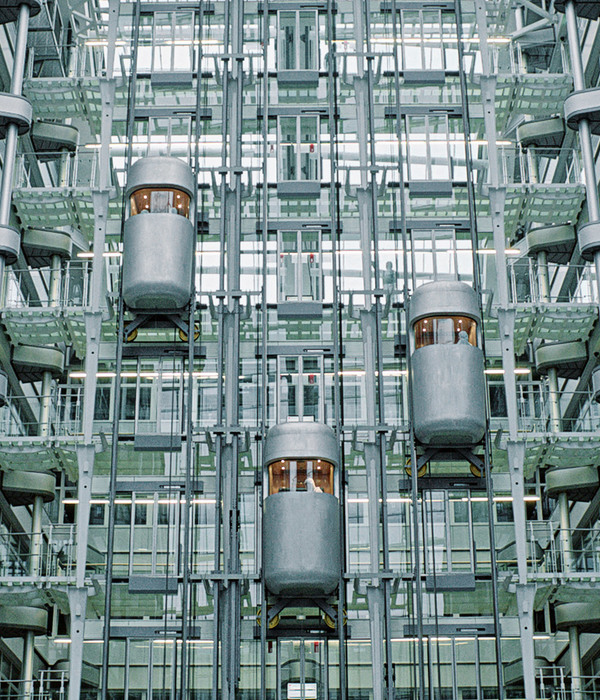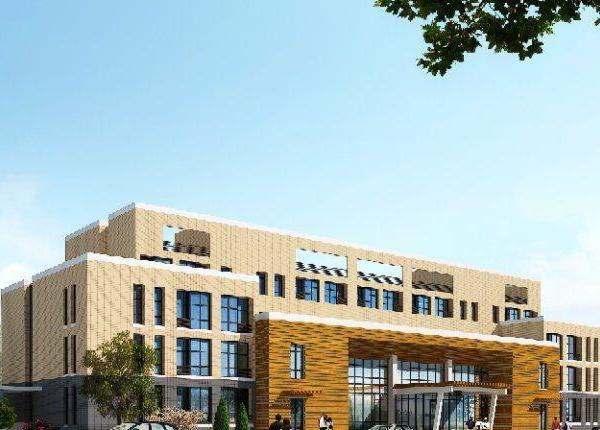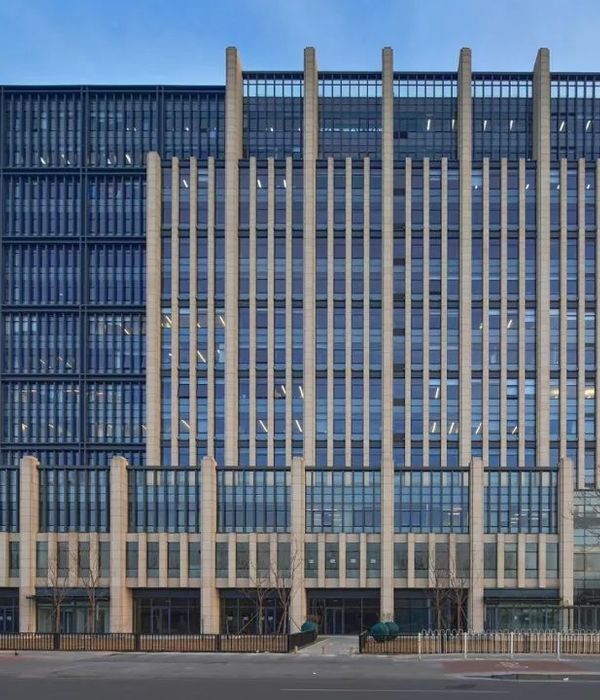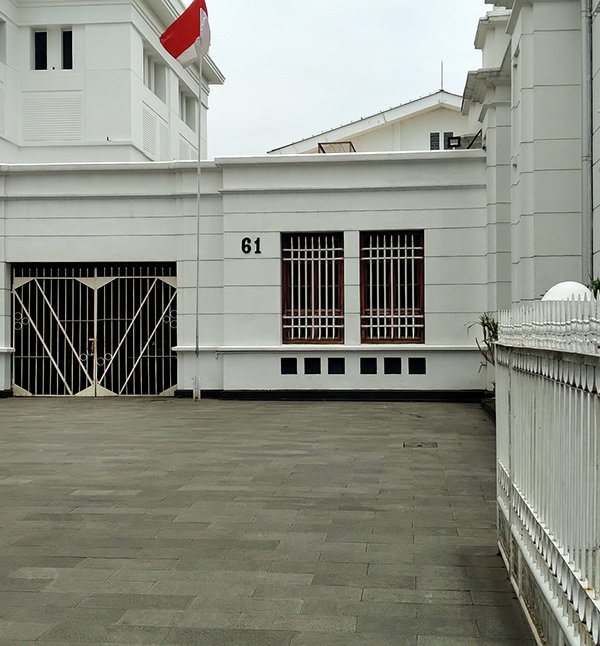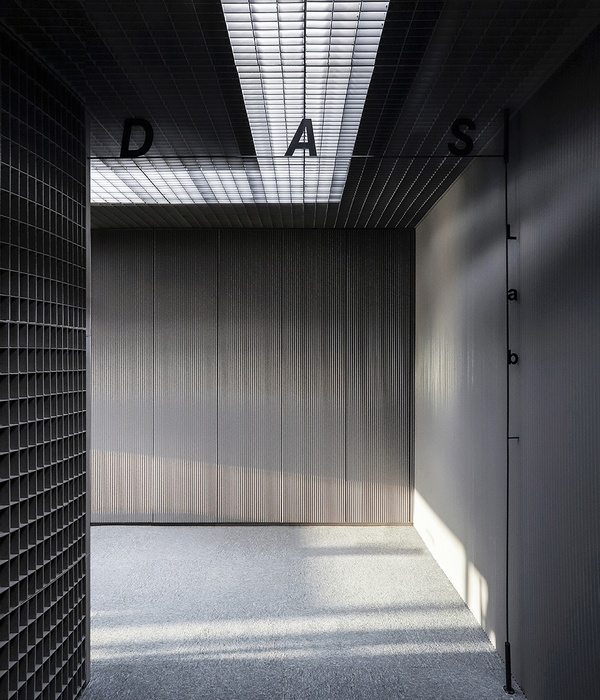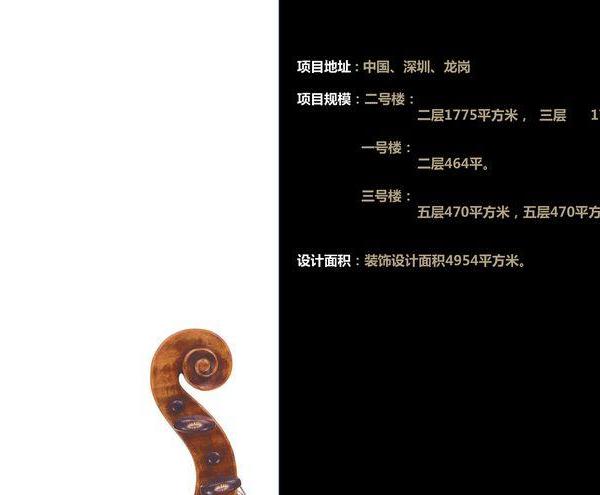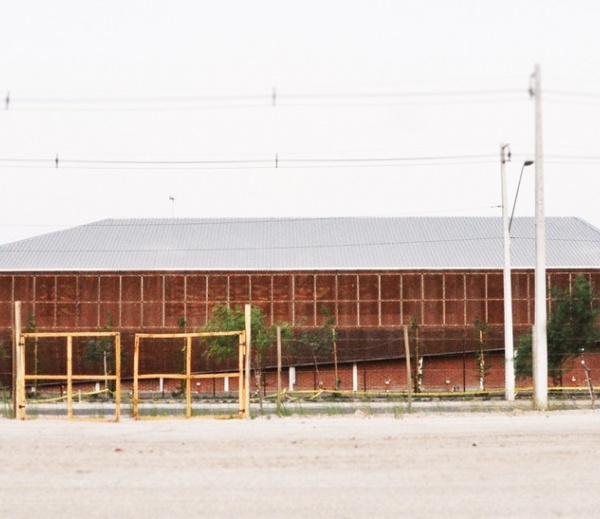烟波浩渺的高邮湖,波光粼粼的京杭大运河,纵横交错的古城巷弄,灰墙灰瓦的民居,在高高的河堤玩耍的孩童……恬淡而闲适的家乡气息在汪曾祺的笔下显得宁静安然,让人神往。他以饱蘸乡情的笔触,将家乡的一草一木、一人一事复活在他的作品中。
The cultural characteristic block of Wang Zengqi memorial hall is located in Gaoyou City, Jiangsu Province, which is a famous historical and cultural city beside the Beijing Hangzhou Grand Canal. The site is located in the ancient city of Gaoyou, where the grand canal runs through the west. The old streets and alleys around the site are crisscrossed, dense and even crowded, forming a simple and fresh atmosphere of traditional Chinese cities.
▼越过清代老宅屋顶看纪念馆,view to the Memorial Hall across from the roof scape of the old houses ©陈颢
▼纪念馆东鸟瞰,aerial view from east ©陈颢
汪曾祺 (1920—1997),中国当代著名作家,被誉为“中国最后一个士大夫”,“抒情的人道主义者”。“我的家乡是一个水乡,我是在水边长大的,耳目之所接,无非是水。水影响了我的性格,也影响了我的作品的风格。”邮驿通华夏,运河贯古今,高邮因水而生,因邮而名,因文而兴。“古有秦少游,今有汪曾祺”,汪曾祺纪念馆便坐落在这片水网交织的高邮古城里。
Wang Zengqi (1920-1997), a famous contemporary Chinese writer, is known as “the last scholar bureaucrat in China” and “Lyric humanist”. “My hometown is a water town. I grew up by the water. Water is everywhere that immersing all my senses. Water has affected my character, as well as the style of my work. ”, With his passion bounding to his hometown, Wang Zengqi revived every detail of his hometown into his works, down to every vegetation and persona. As the saying goes “Gaoyou City was proud to have Qin Shaoyou in the past, while Wang Zengqi at the present”, the design of the memorial hall requires consideration of Mr. Wang’s rich literary achievements and artistic life, while echoing the regional culture and nature of Gaoyou at the same time.
纪念馆主入口透视,main entrance ©陈颢
基地位于古城西北角,近高邮湖和大淖河,周边是典型的由老街和巷弄组成的传统城市生活街区,致密甚至有些拥挤的空间里充满了朴实而鲜活的烟火气。北侧的人民路连接着大运河和文游台(北宋词人秦少游纪念地),街边的商铺与民居、湖水与运河一起共同承载着汪老对于故乡的回忆。
▼基地建成前后图底关系,the site before and after the project was completed ©TJAD
▼纪念馆东北透视,northeast view ©陈颢
▼文化特色街区西南透视,cultural characteristic block ©陈颢
汪曾祺生活过的“汪家大院”旧址位于基地北半部分,如今只有沿西侧竺家巷两栋小楼存留,挂有“汪曾祺故居”牌匾;基地北侧的沿人民路的商铺(汪曾祺小说里多次出现的场景原型)、西南侧清代老宅以及东侧的四棵大树均被保留,它们如同基地的年轮,刻画着场地的历史与城市记忆。
▼文化特色街区轴测,cultural characteristic block – axon ©TJAD
Several large trees are preserved at the east of the site, while on the west side, there are old houses of Qing Dynasty and Wang Zengqi’s former residence need to be preserved and repaired. On the north side of the site, the Renmin Road leads to the Grand Canal on the west, and the famous Wenyoutai (the memorial of Qin Shaoyou, a poet of the Northern Song Dynasty)on the east. The shops along Renmin Road carry the memories of Mr.Wang’s childhood. Many of his literary works are derived from the canal and the network of water streaming within this Ancient city.
▼文化特色街区西北鸟瞰,cultural characteristic block – aerial view from northwest ©陈颢
整个文化特色街区的空间构成,是以纪念馆为核心,周边布置汪氏家宴、汪家客栈、汪迷部落以及汪老书吧。街区的概念,是希望从场所精神中重构新的空间体系和文化内容,让街区更新与再生,“锚固”城市肌理,让设计融入市井生活。通过还原汪曾祺艺术人生的原点,从多维度展现他对于文学、生活以及生命的感悟,从而尝试重构城市的文化精神。
▼文化特色街区功能构成,cultural characteristic block – programme ©TJAD
The design arranges the Wang’s family banquet, Wang’s Inn and Wang’s Fan Club along the south and west sides of the cultural district. With gray walls and tiles, the exterior forms create a coherent architectural language of “background color” with the reserved shops along the north, the former residence of Wang Zengqi at the west, and the old house of Qing Dynasty, blending themselves in this ancient city. The concept of the block is intended to “anchor” the urban texture, to integrate the design into the city life, to evoke the city memories of Wang Zengqi’s works about Gaoyou, while restoring the origin of Wang Zengqi’s artistic life, and to demonstrate his perception of literature and life in multiple dimensions.念馆北侧鸟瞰,the Memorial Hall – aerial view from north ©陈颢
▼远眺纪念馆、大淖与高邮湖,the Memorial Hall, the Danao Lake and the Gaoyou Lake ©陈颢
越过纪念馆涟漪般起翘的屋顶,可以远眺浩浩汤汤的高邮湖。湖边的京杭大运河与高邮老城擦肩而过。在汪曾祺的作品和谈话中,不乏有这样的描述:“城的地势低,据说运河的河底和墙垛子一般高。我们小时候到运河堤上玩,可以俯瞰人家的屋顶”。可以说,“水”、“城”、“间”三者构成了汪曾祺文学作品的主要空间与环境特色,这种特色与高邮古城肌理相契合。
In Wang Zengqi’s works and interviews, often exist such descriptions: “the city’s terrain is low, it’s said that the bottom of the canal is as high as the buttresses. When we were children, we played on the bank of the canal, overlooking other people’s roofs. ” It can be said that “water”, “city” and “space” constitute the main aspects about space and environmental characteristics in Wang Zengqi’s literary works, which is coherent with the texture of Gaoyou ancient city.馆一层剖轴测,Memorial Hall ground floor axon ©TJAD
纪念馆二层剖轴测,Memorial Hall first floor axon ©TJAD
纪念馆采用非对称平面,将七个记忆的盒子叠放在一层基座上。纪念性空间的叙事性通过盒子之间的串联组合,带来空间的序列和体验节奏的变化。一层基座由纵横交错的片墙组成,通过墙体之间的组合、拉伸、转折、对位,形成了平面的错动与空间的收放曲折,与二层相对规整的盒子布局形成了对比,共同形成整体的空间韵律。
The ground floor of the memorial hall is formed with crisscross panels of walls, among them, the west oriented ones are rotated at a certain angles, facing Wang Zengqi’s former residence, the old house of Qing Dynasty and Wang’s Inn respectively; meanwhile the second floor mass were considered as jewelry cases, floating above the crisscross walls of the ground floor. Such design is not only integrating into the urban texture of the ancient city, but also accommodating the achievements of Wang in different literary fields, as if collecting the pearls in the jewelry cases. The two courtyard spaces (water court and tree yard) are designed to salute the traditional residential courtyard space.
纪念馆负一层水院,the water yard on the lower floor ©陈颢
纪念馆错动的形态形成了两个庭院,江淮的雨水顺着起翘的屋顶汇入中央的“水院”,也流入汪迷们的心田,让日常的天井有了静默的纪念性;喃喃的风声略过南侧汪老书吧的“树院”,也拂过院中汪老的坐像,让书吧中的读者能隔窗与汪老展开心灵对话。
▼纪念馆主入口透视,main entrance ©陈颢
纪念馆主入口广场,main entry yard ©陈颢
设计强调纪念的“日常性”来呼应汪曾祺的创作特点——以个人化的市井生活题材,使“日常性审美化”。入口广场以汪迷部落作为背景墙,北侧的悬弧线坡道可以直通屋顶眺望纪念馆,并可通过连廊和螺旋楼梯到达纪念馆二层以及汪园,由此形成的空间对话与交流,在看与被看的转换中,完成日常性与纪念性的转化。
▼连接汪迷部落屋顶与汪园的楼梯与廊道,the stairs and corridors that link the Wang’s Fan Club toWang’s Garden ©陈颢
纪念馆与周围保留建筑之间的留白区域被设计成“汪园”,将纪念性庭院外化为日常性百姓游憩空间,凿池引水,置石拟山,以自然山水庭院的开放姿态串联起街区内建筑,尺度亲切,空间温馨,让周围居民能在轻松惬意之中体会汪老文字中对于生活之美的感悟。
▼纪念馆西侧汪园,Wang’s Garden ©陈颢
▼汪园局部,detailed view ©陈颢
汪园景观,landscape ©陈颢
纪念的日常性同样体现在由青砖与混凝土构成的外立面。纪念馆一层基座的片墙由青砖红砖构成,大多都是场地拆迁时得以保留,在东立面上形成了“高邮山水图”致敬当地文脉,也赋予了外墙以纪念性意义;沿着入口广场北侧弧线坡道走上汪迷部落的屋顶,好似从街道走上运河的堤岸,坡道与屋面的青瓦立砌铺装也来自拆迁时的保留,徜徉其间,还可以“看别人家的屋顶”,场地“基因”得以延续的同时,也强化了生活场景的纪念性。
In terms of building materials, the architects utilized the old bricks kept over time from site demolition to form the street side facades. The bricks are designed to portray “the landscape of Gaoyou”. The old bricks and tiles are also used to pave the pavement, ramps and roof of Wang’s Fan club. Walking within, it is evident that the “gene” of the site continues to live. These elements not only continue the cultural tradition of Gaoyou, but also arouse people’s memories of the place.
▼汪迷部落屋顶,roof top view of Wang’s Fan club ©陈颢
▼纪念馆东侧“高邮山水图”,“the landscape of Gaoyou”on the east facade ©陈颢
“高邮山水图”细部,detailed view ©陈颢
纪念馆选择清水混凝土作为主要材质,与汪老简约而朴素的文风相契合,同时,以暖灰色的基调致敬汪老“人间送小温”的文学情怀。细致的木纹凹凸肌理,则进一步丰富了建筑表情,引发文学般的诗意。从负一层到一层的水平通缝,到二层的深浅交错,形成了似涟漪又似水岸湖岸被水流侵蚀后的褶皱,汪老作品如水,一生仅三次返乡,那写不尽的乡愁化作一道道凹凸肌理,赋予了混凝土外墙独属于汪曾祺的纪念性。
The main tone of the material of the memorial hall is warm gray fair faced concrete, paying homage to Wang’s literary feelings of “gifting little warmth to the world”. The fine erratic wood texture further enriches the architectural expression and inspires to “poetic” literary.
纪念馆混凝土材质渐变肌理,thegradually variedtexture of the concrete walls ©陈颢
纪念馆室内空间构成,重点刻画入口门厅及台阶式休息厅,观展流线在两者之间迂回转折,形成空间节奏上的变化。双螺旋楼梯成为入口大厅的视觉焦点,而钢索悬挂的 L 形连廊成为台阶式休息厅的空间特色。
▼纪念馆剖面分析,sectional perspective ©TJAD
The interior space of the memorial hall is mainly characterized by the entrance hall and the rest hall with steps. The exhibition circulation twists and turns between them, forming the variation in spatial rhythm. The double spiral staircase becomes the visual focus of the entrance hall, while the L-shaped corridor suspended by the steel cable becomes the unique spatial feature of the rest hall.
▼纪念馆双螺旋楼梯,the double spiral staircase ©陈颢
纪念馆通高玻璃门厅,the full-height entrance hall ©陈颢
纪念馆展厅旋转盒子看汪园,view to Wang’s Garden from the exhibition hall ©陈颢
纪念馆展厅室内,exhibition hall ©戴雨航
纪念馆展厅,exhibition hall ©陈颢
纪念馆展厅室内细节,interior details ©戴雨航
纪念馆剖面分析,sectional perspective ©TJAD
纪念馆休息厅悬挂连廊,the hanging corridor in the Rest Hall ©陈颢
掀起一角的三角窗成为展馆的标志性元素。三角窗长长的起翘,让混凝土盒子不再笨拙与封闭,有了“如翚斯飞”的神韵。窗内展示的是汪曾祺的文学世界,窗外则是他所描绘的现实世界,一束阳光透过三角窗洒在汪老的书桌上,内外世界仿佛穿越时空般交流……这掀起的一角,也让观者在参观过程中,不经意间“可以俯瞰人家的屋顶”。
▼纪念馆三角窗元素,exterior view to the triangular window ©陈颢
The triangular window at the corner of each mass has become a feature element of the memorial hall. The long warping corner above the triangular window removes the clumsiness and heaviness of the cubic concrete masses, and has the charm of “flying cornices” as well. Behind the window displays Wang Zengqi’s literary world, while the real world depicted by him is displayed on the outside. A beam of light is sprinkled on Wang’s desk through the triangular window, the internal and external worlds seems to communicate through time and space. These raised corner windows also allow visitors to inadvertently “overlook the roof of others” as described in Wang’s works.
纪念馆展厅三角窗内景图,triangular window diagram ©TJAD
▼纪念馆三角窗室内,interior view to the triangular window ©戴雨航
纪念馆展厅,exhibition hall ©戴雨航
纪念馆展厅,exhibition hall ©陈颢
通过螺旋楼梯可以到地下一层,这里有咖啡休息厅和临时展厅,它们围绕水院布置。这里可以凝视墙上汪老深邃的文字,也可回看入口大厅的人来人往。结束完参观,如果还意犹未尽,可以去文化街区南侧的汪氏家宴与汪家客栈继续品味。
▼纪念馆剖面分析,sectional perspective ©TJAD
The spiral staircase also leads to the underground floor. Coffee lounges and temporary exhibition halls are located here, which are arranged around the water yard. Here you can gaze at Wang’s profound words carved on the walls, or look back at the entrance hall and watch others navigate around. Wondering through the lecture hall at the ground floor, you will also encounter the Wang’s book bar. It is a peaceful place to get lost in books and have a spiritual dialogue with a statue of Mr. Wang sitting in the tree court through the window.
▼纪念馆负一层“水院”看门厅,view to theentrance hall from the water yard ©陈颢
汪曾祺在谈论小说创作的体会时曾说“要贴着人物写”,汪曾祺纪念馆文化特色街区,以日常性纪念的方式让汪曾祺的个体叙事重归社会。从街区布局到纪念馆设计,从空间构成到材料与细部表达,都试图“贴近”汪曾祺,“贴近”高邮古城,让纪念性空间叙事与城市更新重合。用汪老的话说,“我希望能做到融奇崛于平淡,纳外来于传统,不今不古,不中不西。”
From the block layout to architectural design, and from space composition to materialization and detail implementation, the cultural characteristic block of Wang Zengqi memorial hall tries to “unite” with Wang Zengqi and to “unite” with the Gaoyou City. In Wang’s words, “I hope to blend the novelty with the plainness, absorb foreign within the traditional, neither present nor past, not only from Chinese but also form the world.”
纪念馆文化特色街区西南鸟瞰,aerial view to the cultural characteristic block ©陈颢
▼纪念馆文化特色街区东西剖面,east-west section of the block ©TJAD
▼纪念馆文化特色街区南北剖面,south-north section of the block ©TJAD
▼总平面图,site plan ©TJAD
▼纪念馆一层平面图,ground floor plan of the Memorial Hall ©TJAD
▼纪念馆二层平面图,first floor plan of the Memorial Hall ©TJAD
▼纪念馆屋顶平面图,roof plan of the Memorial Hall ©TJAD
立面图,elevation ©TJAD
▼剖面图,section ©TJAD
设计单位:同济大学建筑设计研究院(集团)有限公司设计团队:建筑/江立敏,王涤非,戴雨航,崔仁龙,吴宾,熊濯之结构/朱亮,刘冰,何忻炜,张硕,杨辉给排水/李丽萍、王纳新,徐钟骏,金伟格,暖通/钱必华,王钰,秦卓欢,张萍电气/宋海军,朱亚军,李玉芝,羊元鑫展览策展/李翔宁,张子岳,莫万莉,邓圆也,杨小咚等室内实施/张伟,陈磊,杨金宇,林帆景观/江立敏,王涤非,戴雨航,张宇辉等灯光/杨秀、陈幸如、徐霞青、葛雪婷、周婉媛、杜怡婷幕墙/田利军,邹凯雕塑:中央美术学院秦璞委托方:高邮秦邮旅游开发有限公司施工方:总包/江苏建宇建设集团有限公司清水混凝土施工/上海清水砼科技发展有限公司展陈施工/江苏大美天第文化产业有限公司景观施工/江苏华泰路桥建设集团有限公司楼梯施工/上海善治楼梯科技有限公司雕塑制作/北京绥邦文化发展有限公司
Design Team: Architecture / Jiang Limin, Wang Difei, Dai Yuhang, Cui Renlong, Wu Bin, Xiong Zhuozhi
Engineering: Zhu Liang, Liu Bing, he Xinwei, Zhang Shuo, Yang Hui
Water supply and drainage / Li Liping, Wang Naxin, Xu Zhongjun, Jin Weige
HVAC / Qian Bihua, Wang Yu, Qin Zhuohuan, Zhang Ping
Electric / song Haijun, Zhu Yajun, Li Yuzhi, Yang Yuanxin
Indoor implementation / Zhang Wei, Chen Lei, Yang Jinyu, Lin Fan
Indoor exhibition / Li Xiangning, Zhang ziyue, Mo Wanli, Deng Yuanye, Yang Xiaodong, etc.
Landscape: Jiang Limin, Wang Difei, Dai Yuhang, Zhang Yuhui, etc
Lighting / Yang Xiu, Chen Xingru, Xu Xiaqing, GE Xueting, Zhou Wanyuan, Du Yiting
Curtain wall / Tian Lijun, Zou Kai
Sculpture/ Qin pu , Central Academy of Fine Arts
Clients: Gaoyou Qinyou Tourism Development Co., Ltd
{{item.text_origin}}

